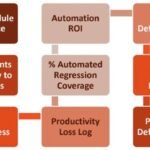As the fast-paced digital world unfolds, cloud mobile phone testing has emerged as a critical aspect for organizations that want to launch quality applications. Diversity in mobile devices, diverse Operating Systems (OSs), various screen sizes, and hardware specifications characterize mobile devices. This diversity will eventually lead to fragmentation challenges. To minimize this, most organizations are adopting AI and cloud-based solutions.
This article discusses how AI might be used to overcome fragmentation challenges in mobile testing and some of the benefits that cloud-based platforms like LambdaTest can provide.
Understanding Fragmentation in Mobile Testing
Fragmentation is the diversity that exists among devices. There are thousands of unique Android devices and various iOS models; making sure that all of them work out perfectly is challenging for developers or testers. Problems that arise due to fragmentation include:
- OS Variability
Variability in the OS performance of apps may change based on different versions of OS installed. For example, something that works fine on Android 12 may misbehave with Android 11. This may annoy a user who cannot upgrade his or her device at that moment.
- Device Diversity
Every device has different specifications, and hence applications work differently. The differences between the CPU, RAM, and storage may create performance variations between devices. A high-end smartphone will run applications that require significant resources without difficulty, while the same application would be difficult to run for a budget device.
- Screen Sizes and Resolutions
Applications have to support a very broad range of screen sizes, which is complex for design and functionality. Some applications that look fantastic on a big tablet look terrible on a smaller smartphone. This requires the usage of responsive design techniques.
- Network Conditions
Changes in network speed and reliability may affect the User Experience (UX). An app running smoothly on Wi-Fi may face issues on a slower mobile network. Testing under different network conditions is very important to ensure that users have a consistent experience.
These challenges require a strong testing strategy to ensure that applications perform optimally across all devices.
The Role of AI in Mobile Testing
AI is changing mobile app testing and offers tremendous means to mitigate the effects of fragmentation. A few ways AI contributes include:
- Predictive Analytics
AI algorithms analyze user behavior and device data to predict trends. The benefit for developers is that they can prioritize which devices to support based on actual usage patterns. For example, if analytics shows that the most usage is happening on a particular model of the device, organizations can focus attention on that.
- Responsive Design
AI will adaptively change design elements based on screen size and user engagement to ensure there’s an overall smooth experience, whatever the difference in devices might be. It keeps users interested because of that adaptability.
- Error Prediction
AI tools predict the errors in the code, even before they occur in the app. The chances of having higher reliability will be greater, thus saving much time and resources. Early detection of common pitfalls at the development cycle stage helps a lot.
- Automated Test Generation
It generates test cases based on the interaction between users and the application. So, less manual effort will be made with greater coverage.
- Smart Test Prioritization
With the help of AI, tests can be prioritized for non-failing data or data associated with feature criticality in the minds of the users. The core parts of the application are certainly released first through testing.
Fragmentation management capabilities in an organization may be stronger through the integration of AI into the testing process.
Advantages of Cloud Mobile Testing in Case of Device Fragmentation
Cloud mobile testing uses cloud computing to provide total access to hundreds of thousands of real devices without having to utilize the physical devices themselves. Some of the associated benefits include:
- Access to Real Devices
Tests are executed on actual, cloud-hosted devices. There is no guesswork about emulation or simulation.
- Simultaneous Testing
Cloud-based platforms can run tests on a variety of devices and platforms in parallel, accelerating the testing process. Concurrent execution is important to support rapid iteration in agile environments.
- Cost Efficiency
Since the organization has no expenses such as those tied to an extended physical device laboratory, there’s no purchase but a pay as a need arises model.
- Scalability
With time, the increasing growth of this organization calls for increased testing demands. Cloud services are easily scalable upwards and downwards according to the changing needs of each project without large investments in structures.
- Environment Consistency
The cloud provides identical and non-deviant environments rather than variations of the local configurations and hardware.
Overcoming Fragmentation Challenges with Cloud Testing Platforms
There are some excellent leaders in the space, with platforms offering trusted and scalable cloud infrastructure tailor-built for mobile testing. A lot of other solutions have recently begun to shift away from local labs and use distributed cloud and local labs simultaneously for mobile applications and testing.
Mobile application development is rapidly moving. In the present world, the biggest issue that any organization has to face is fragmentation. When there are numerous devices, OSs, and screen sizes, ensuring performance on any one of them could be a challenge.
Cloud testing platforms have proved to be very effective solutions for the issues of fragmentation; they help organizations deliver applications of high quality efficiently.
One such platform that excels in this area is LambdaTest. It offers a reliable and scalable cloud infrastructure designed specifically for cloud mobile testing.
Its blazing-fast automation capabilities ensure that the release cycle is faster due to the ease with which it allows teams to run automated tests, thus quickly giving feedback and allowing developers to fix issues very fast. It supports a lot of frameworks like Selenium, Cypress, Puppeteer, Playwright, and Appium.
That makes the platform versatile enough so that teams can choose the right tools for the project. The access to over 3000 desktop and mobile environments enables testers to check compatibility across an extensive range of configurations, ensuring they cover the edge cases they would otherwise miss.
Auto-heal is one feature where LambdaTest automatically recovers from flaky tests. It enhances the reliability of tests without manual intervention, and in the Continuous Integration and Continuous Delivery or Deployment (CI/CD) pipeline, where every second counts, it’s especially valuable.
Additionally, it prioritizes security with SOC2 Type 2 certification and GDPR compliance, allowing organizations to test their applications with the comfort of knowing that data is protected.
It also offers real-time collaboration among the team members through sharing the test results instantly. This will help the developers to have better communication with the testers and thus ensure that issues are resolved quickly.
Apart from these, the reporting features available with the use of LambdaTest provide detailed reports for the teams. Thus, based on comprehensive results regarding the test, organizations know where the problems occur. Therefore, informed decisions can be made for further developmental activities.
Lastly, LambdaTest integrates with highly known CI/CD tools such as Jenkins, CircleCI, and Travis CI. This would further help teams implement automation into their testing workflows without losing an eye on ensuring that tests are run through the developmental pipeline.
With this feature in alignment, organizations would now be capable of overcoming fragmentation in mobile app development and ensuring a seamless UX across all devices and platforms.
Real-Life Applications of Cloud Mobile Testing
For a better understanding of how cloud mobile phone testing is effective with help from platforms, there are a few real-life scenarios:
- E-Commerce Applications
An e-commerce organization needs to test its app on different devices during peak shopping seasons, such as Black Friday or Cyber Monday, when traffic spikes dramatically. Using the extensive range of coverage by cloud platforms allows them to ensure optimal performance under heavy load across multiple platforms simultaneously.
- Gaming Apps
This is a gaming company that continuously updates its products but faces the challenge of ensuring that its products are compatible with all devices since fragmentation is part of the gaming world.
In this case, they will use automation capabilities and real device access to make their updating process easier without compromising the quality of all the supported devices.
- Healthcare Applications
Being a healthcare organization, it demands very rigorous regulation concerning data security yet needs to provide almost transparent application experiences across varied user bases, like patients using a smartphone and doctors using tablets.
With the secure infrastructure provided by cloud setup, it not only performs intense testing but also ensures compliance with the industry standards without compromising on speed or efficiency.
These are examples of how the utilization of cloud-based platforms allows organizations in any field to bridge fragmentation-related problems while maintaining quality at all development stages.
Best Practices for Cloud Mobile Testing
To ensure proper implementation of cloud mobile phone testing on platforms such as LambdaTest, here are some best practices that need to be implemented:
- Define Clear Testing Objectives
Understand what success in your application may look like in terms of the performance benchmarks it will meet and the UX metrics with everyone involved for a clear understanding to be achieved on what is hoped for during a testing phase.
- Prioritize Devices Based on User Data
Use analytics tools integrated within your application ecosystem, such as Google Analytics, and third-party services, such as Mixpanel, to identify which devices users have disproportionately used.
Subsequently, prioritize your testing efforts in those directions, focusing resources where they will make the greatest positive impact, ultimately ensuring better overall user satisfaction.
- Automate Where Possible
Leverage automation capabilities within platforms like LambdaTest effectively; automate repetitive tasks while maintaining accuracy throughout your tests. This not only saves time but also allows teams more bandwidth for exploratory testing.
- Regularly Update Test Cases
As your application evolves with new features or updates regularly over time, ensure your test cases are updated accordingly. Keeping them relevant helps catch regression bugs early before they reach end-users.
- Engage Stakeholders Early On
Involve stakeholders from development QA product management early during each iteration cycle; gathering diverse insights improves test coverage effectiveness while fostering collaboration between teams.
- Monitor Performance Continuously Post-Deployment
After launching an application into production, its performance is continuously monitored using monitoring tools. Understanding how it performs under real-world conditions helps identify areas needing improvement quickly.
- Conduct Regular Training Sessions
Being updated with innovative features introduced by cloud platforms keeps team members productively engaged. Knowledge shall be shared amongst the members of teams by holding regular training camps.
Conclusion
To conclude, mobile technology is changing fast, and it would be a must to conquer the fragmentation challenges to deliver quality applications consistently from organizations. AI and cloud-based solutions allow developers and testers to ensure applications perform well despite the diversity of the landscape.
Advanced features include auto-healing capabilities and extensive device coverage for navigation into complexities in many effective ways. This can be done through cloud mobile phone testing that leverages AI to streamline processes and enhance the quality of applications. Organizations stand well-positioned to meet user expectations and perform in competitive landscapes.
Integration of AI into processes and the use of cloud platforms improves efficiency and reliability throughout the software development lifecycle, which will increase user satisfaction. Innovation within the development teams and better preparation for future challenges in an increasingly competitive market.







